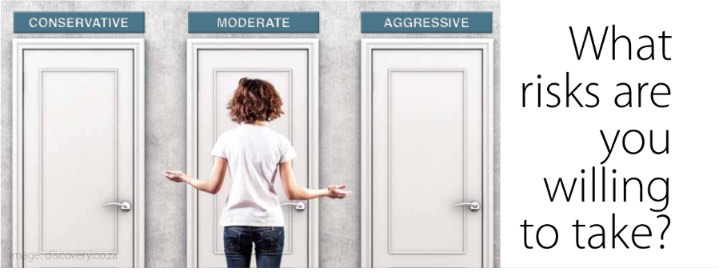Recently we’ve shared several articles on investments, and then we came across this gem from Discovery! It digs a little deeper into understanding your own, personal, risk profile and how that pertains to your investment choices and behaviour. Remember, this is a snapshot typical behaviour types; before making any investment choices, let’s chat first!
Identifying and understanding your risk profile will help guide us to the types of investment funds that suit your specific financial goals.
What type of investor are you?
When choosing your investment approach, it is important to consider your risk profile, which indicates how much investment risk you are willing to take to achieve the investment returns you are aiming for.
All investments have some level of risk. This is why it’s good for us to have a chat to chart the plan of your financial success. Even investing all your money in cash carries the risk of your investment not keeping up with inflation. Risk is not the pretty side of investing, but there are many strategies to managing risk – let’s take a closer look at risk…
Understanding investment risk
Your risk profile and tolerance will differ from another investor based on individual circumstances such as: how long you need to invest, whether you are investing for retirement or for a shorter-term goal, and whether you are investing your entire portfolio, or only a portion of it.
When we meet, we will use a method of “risk profiling” to determine your attitude to investment risk, and your tolerance of investment fluctuations.
There are numerous approaches to risk profiling, we would most likely consider the following factors:
1. How old are you?
Typically, a younger investor can afford to take a long-term investment view and follow a more aggressive approach. They would typically have a higher holding of riskier assets (such as equities) than an older, more conservative investor who would have a higher holding of cash or bonds.
2. How many years are you likely to wait before starting to withdraw from your investments?
It is important to know when you will need to start taking some or all of your money out of your investment. The longer your investment grows, the more likely you are to include a higher proportion of riskier assets. The moment you start withdrawing from your investment, you need to be more conservative about what risk you introduce to your portfolio.
3. What is the approximate net value of your current investments?
By evaluating all your assets and liabilities, a we can determine what percentage you are investing in certain assets. Sometimes, investors choose to place a small portion of their overall investment in riskier assets while following a relatively conservative approach with the majority of their portfolio. Other investors choose the opposite.
4. How do you expect your income to grow in the next few years?
It is important to understand if your income is likely to grow and by how much. This gives an indication of the disposable income you will have to add to your investment.
5. How will you cover the major costs (including costs of dependants) you are likely to incur before retirement?
If your day-to-day living costs are paid out of your salary, it means that there is less chance that you will need to liquidate an investment to cover university fees or other unforeseen costs.
6. How would you react to fluctuations in the market?
A conservative investor is typically more sensitive to major market swings than an aggressive investor. For example, if you lost 10% of the value of your portfolio in one day, but made 30% on another occasion, would you be comfortable? Some investors prefer smoother returns that don’t fluctuate considerably.
All these considerations help us determine whether you are a conservative, moderate or aggressive investor. This is a reliable guide to the types of investments we will recommend and the percentage of your total portfolio invested in different asset classes.
Don’t be afraid of risk
Being a conservative or moderate investor means that you don’t put all your money in a risky asset class. However, it is important that you don’t become so risk averse that you make irrational investment decisions. No investment is risk free and if you are investing in the first place, you need to understand how to use risk, not fear it. For example, in October 1987 stock markets globally fell by more than 20% in one day, this was known as Black Monday.
A conservative investor may have panicked in this situation and sold their remaining investment to prevent further losses, a moderate investor may have kept their investment and waited for a market recovery, while an aggressive investor may have seen an opportunity to buy cheap assets while markets are down.
Understanding investment risk will help you use it to maximise investment returns. There is place for risk in an investment portfolio (no investment portfolio is completely free of risk), and if used correctly can help boost your investment returns.
Your risk profile changes
Once you have completed a risk profiling questionnaire and determined your risk profile as an investor, it’s important you revisit your risk profile, with your financial adviser, at regular intervals. Your risk profile is not static and may change over time. As you go through life, your profile will naturally transition from an aggressive approach to a more conservative outlook. Or you may find that you become a more experienced investor and change from a very conservative approach to a moderate one. Evaluating your risk profile is as important as regularly evaluating your investment portfolio. You need to ensure that it remains relevant and appropriate to your needs as an investor.

It is important for us to map your personal level of investment risk with your financial goals to ensure that you are in the best position to achieve your objectives. If you have some questions or need to reevaluate your risk profile – let’s hook up!
